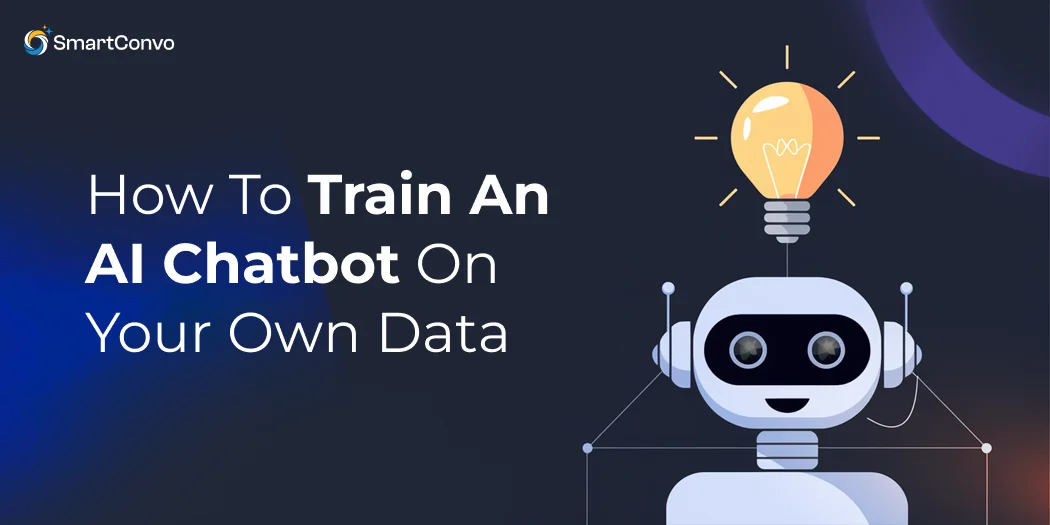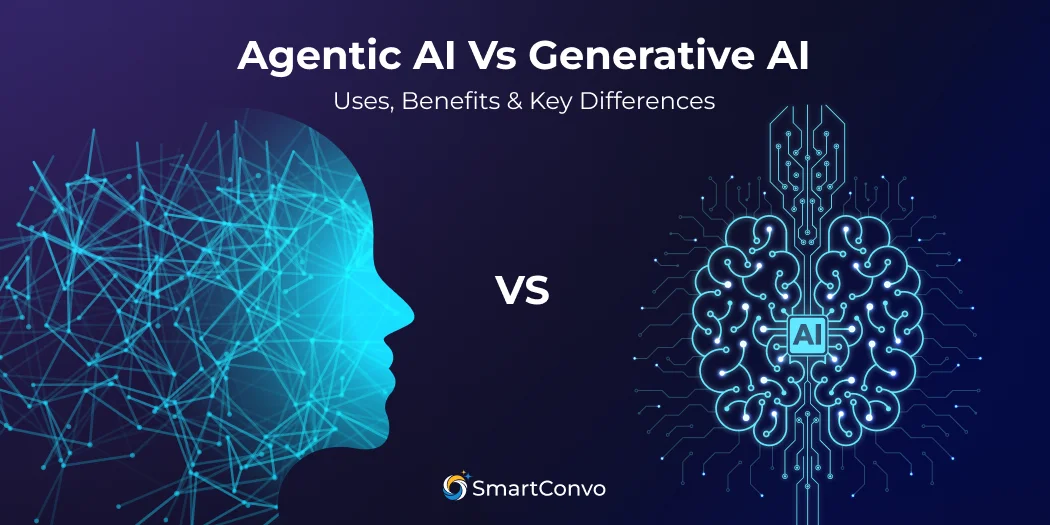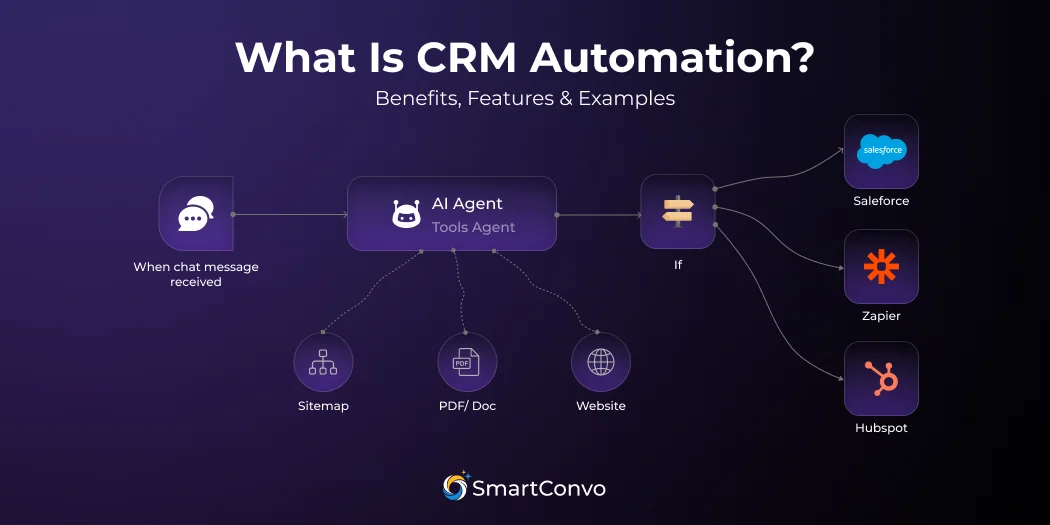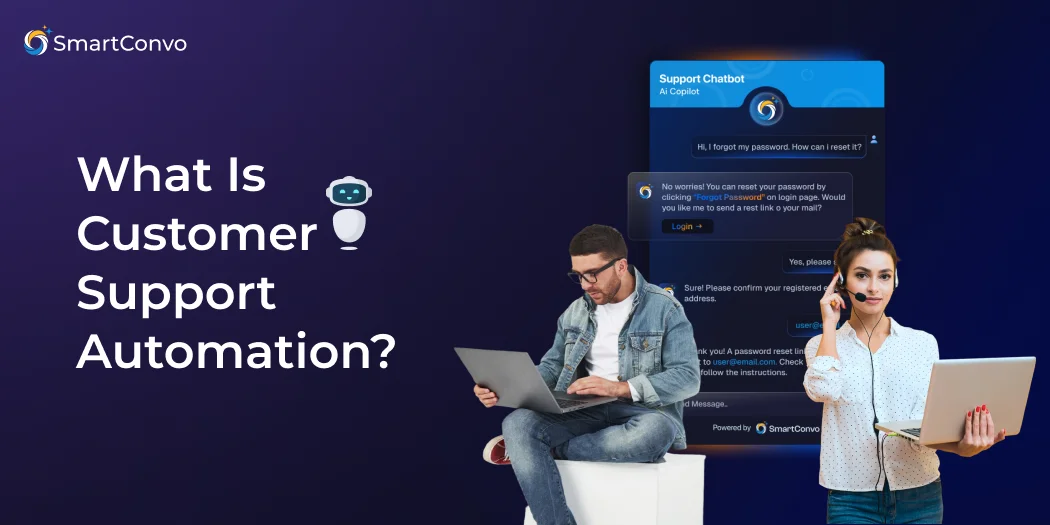What if I told you that creating a customized AI chatbot tailored to your business could save time, cut costs, and dramatically improve your customer experience? Imagine a tool that not only handles repetitive queries but also provides personalized responses, engages customers effectively, and frees up your team to focus on more complex tasks. The key is to train an AI chatbot entirely on your own data, allowing you to fine-tune it for your unique business needs and goals.
With conversational AI tools becoming a vital asset for businesses across all industries, more small business owners, marketers, and tech enthusiasts are seeking ways to unlock their full potential. Whether you’re running an e-commerce store, a SaaS startup, or a customer service center, a well-trained chatbot can streamline communication, drive engagement, and even help boost conversions.
Why Is Training an AI Chatbot Important?
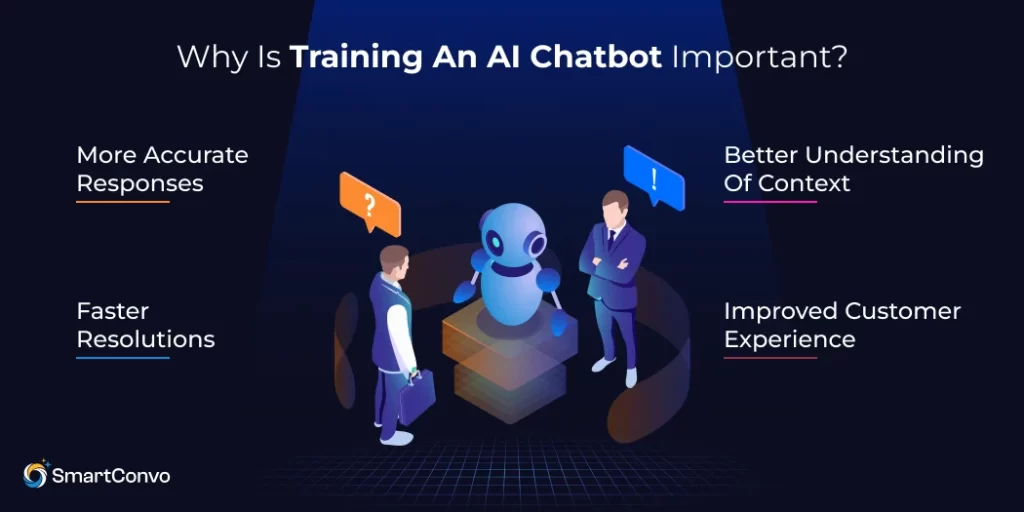
Whether it’s a helpdesk query, a sales pitch, or a basic FAQ response, chatbots have revolutionized how businesses handle customer interactions, making them faster, more efficient, and available 24/7. These intelligent tools can respond to inquiries in real time, solve common problems, and even guide users through complex processes. But why is training an AI chatbot so critical for success?
More Accurate Responses
Chatbots rely on data to function—and the quality of that data directly affects their accuracy and overall performance. Well-structured, high-quality data ensures that chatbots can understand user queries and provide relevant, accurate responses. Effective training, using diverse and representative datasets, helps fine-tune bot behavior, making interactions smoother and more precise. This reduces confusion, minimizes errors, and fosters trust between your business and its users, ultimately enhancing the overall user experience and customer satisfaction.
Faster Resolutions
Training chatbots with relevant and high-quality data allows them to better understand customer requests, improving response accuracy and reducing the time it takes to address inquiries. This not only enhances customer satisfaction but also boosts support efficiency and streamlines overall operations, enabling businesses to handle larger volumes of queries without compromising on service quality.
Better Understanding of Context
Nobody likes vague, irrelevant chatbot replies that leave users frustrated and searching for answers. Well-trained chatbots, on the other hand, can pick up on context, subtle cues, and specific phrasing, providing detailed, accurate, and human-like responses. This level of sophistication not only improves customer satisfaction but also streamlines interactions, saving time for both users and businesses.
Improved Customer Experience
At its core, training own chatbots is all about creating engaging, seamless user experiences that meet the needs of your audience. A well-trained chatbot not only answers questions but does so in a way that feels natural and efficient, leaving users satisfied with their interaction. By providing accurate responses, anticipating user needs, and maintaining a conversational tone, a strong chatbot builds trust and creates a sense of assurance that your brand is reliable, responsive, and attentive.
Why Train a Chatbot on Your Own Data?
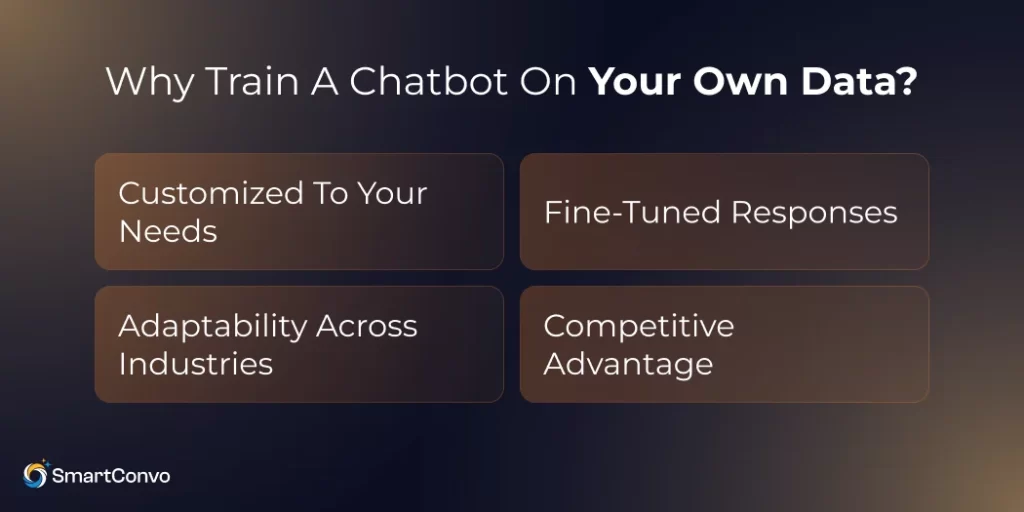
Generic chatbots can be helpful, but they often fall short when it comes to addressing the unique requirements of your business. They may provide generic responses that lack context or fail to meet your customers’ specific needs. Train an AI chatbot on your own data allows for full customization, ensuring it understands your business, products, and services inside out.
1. Customized to Your Needs
Every business is unique, and your chatbot should reflect that. By training your chatbot using knowledge in AI specifically tailored to your products, services, and industry, you can create a personalized experience that truly resonates with your audience and meets their needs. A well-trained chatbot not only improves customer satisfaction but also streamlines your operations, saving time and resources.
For instance, a chatbot for an e-commerce store might focus heavily on tasks like product lookups, order statuses, and personalized shopping recommendations. On the other hand, a chatbot for a healthcare provider would prioritize HIPAA-compliant patient communication, appointment scheduling, and providing quick access to important medical information. By customizing your chatbot’s knowledge base and functionality, you ensure it becomes a powerful tool that enhances your customer interactions and supports your business goals.
2. Fine-Tuned Responses
Generic responses are a thing of the past. With AI chatbot training, you can train your chatbot on your own data to build conversational AI chatbots that provide hyper-specific answers to user queries, tailored to your business or industry. By leveraging your unique dataset, these chatbots can handle complex, nuanced questions with greater accuracy, significantly reducing irrelevant or unhelpful replies.
3. Adaptability Across Industries
From HR Knowledge Management to Conversational AI for Sales, a tailored chatbot can transform operations in virtually any industry. Businesses in retail, finance, and healthcare have unlocked new efficiencies by training AI bots on their organizational knowledge bases to handle repetitive queries, provide instant answers, and streamline workflows. These chatbots not only save time but also improve customer satisfaction by delivering consistent and accurate information 24/7. With the ability to adapt to specific business needs, AI chatbots are becoming essential tools for driving productivity and enhancing user experiences.
4. Competitive Advantage
What sets you apart from competitors? When you train chatbot on your own data, it not only reflects your unique voice, branding, and expertise but also delivers personalized, accurate responses that resonate with your audience. By aligning with your business’s goals and values, it creates a seamless customer experience while helping your business stand out in a crowded market.
How to Train Chatbot on Your Own Data (Effective Methods)
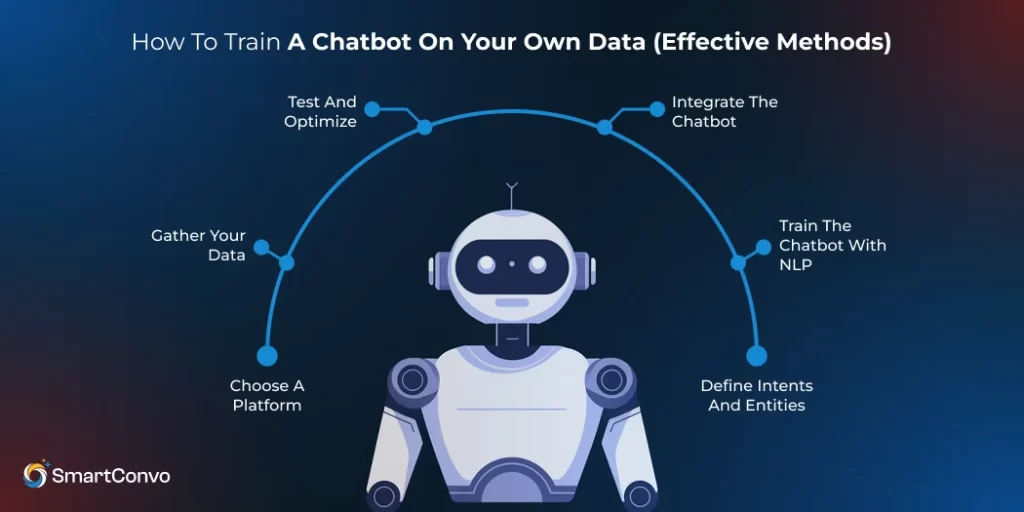
Here’s the secret recipe to build an AI chatbot trained on your data—step-by-step.
1. Choose a Platform
Start by selecting an AI chatbot platform that fits your business needs and goals. Consider factors such as ease of integration, scalability, and customization options. Popular platforms support LLM-based chatbots, which are designed to understand and respond to natural language inputs effectively. Tools like Dialogflow, Rasa, or Microsoft Bot Framework offer robust solutions for creating intelligent and highly adaptable chatbots.
2. Gather Your Data
You can’t train a chatbot without quality data! Start by gathering internal documents, FAQs, support tickets, and any other interactions that are relevant to your business and customer needs. The more specific and comprehensive the data, the better your chatbot will perform. Don’t overlook resources from departments like Helpdesk Knowledge Base, sales, or even marketing, as these can provide key insights into common customer questions and issues.
3. Define Intents and Entities
Intents represent the overall goal or purpose behind what the user wants to achieve, while entities focus on identifying the specific details or pieces of information needed to fulfill that goal. Together, they work to provide a clear understanding of the user’s request within a conversational system. For example:
- Intent: “Find Product Availability” – This represents the user’s desire to check if a product is available.
- Entities: “Product Name,” “Zip Code” – These are the specific details the system needs to process the request, such as identifying the product and its availability in a particular location.
By combining intents and entities, systems can better understand and respond to user needs.
4. Train the Chatbot with NLP
Leverage Natural Language Processing (NLP) technologies to teach your chatbot to process and understand language effectively. Incorporate training datasets that include diverse phrasing, synonyms, and sentence structures to help it recognize a wide range of language variations. By exposing your chatbot to different ways people communicate, you can improve its ability to respond accurately and naturally in real-world conversations.
5. Test and Optimize
Test your chatbot under a variety of scenarios, including common interactions and edge cases that might cause it to respond incorrectly or fail. Pay close attention to how it handles unexpected inputs, ambiguous queries, or complex user demands. Use these tests to identify weaknesses in its algorithms and responses, then fine-tune them to enhance accuracy, reliability, and consistency. Regular testing and adjustments ensure your chatbot delivers a seamless experience across diverse situations.
6. Integrate the Chatbot
Finally, implement your chatbot in key areas of your business, such as your website, mobile app, or messaging platforms, to ensure it reaches your customers where they need it most. By strategically placing the chatbot in these channels, you can provide seamless support, answer customer questions in real time, and enhance overall user experience.
Benefits of Training Your Own AI Chatbot
1. Customized User Experience
A bot trained with your specific data ensures users get exactly what they need, faster and more efficiently. It’s like having a smart assistant tailored to your business, providing personalized service at scale while saving time and improving customer satisfaction.
2. Faster Support, Lower Costs
Automated problem-solving not only reduces the workload on support teams but also ensures timely and accurate resolutions to common issues. By streamlining repetitive tasks and addressing customer concerns more efficiently, automation helps businesses improve response times, enhance customer satisfaction, and boost overall operational efficiency across the board.
3. Consistent Branding
Ensure consistent phrasing, tone, and messaging that reflects your brand’s identity by aligning every interaction with your chatbot to your business voice. Your chatbot’s interface should serve as an extension of your brand, creating a seamless and cohesive experience for users. By maintaining this consistency, you can build trust, strengthen your brand presence, and deliver a more engaging customer experience.
4. Scalability
Chatbots are a powerful solution for scaling businesses, offering an efficient way to manage customer interactions. They handle increased chat volumes effortlessly, ensuring that as your customer base grows, so does your ability to provide timely and consistent support. By automating responses to common queries, chatbots free up your team to focus on more complex issues, improving both productivity and customer satisfaction.
How to Evaluate Chatbot Performance After Training
Phase 1 is done—but your chatbot’s “learning” is never over. Use these methods to ensure it’s performing as intended.
Customer Feedback
Collect detailed user reviews on chatbot interactions to identify strengths and pinpoint areas that need improvement. By analyzing feedback, you can enhance your chatbot’s responsiveness, accuracy, and overall user experience, ensuring it meets user expectations effectively.
Key Metrics
Use data dashboards to monitor key metrics like bot response times, resolution rates, and customer satisfaction scores. These insights help you identify areas for improvement, optimize bot performance, and ensure a seamless customer experience. With real-time tracking, you can make data-driven decisions to enhance efficiency and satisfaction.
Live Testing
Continuously simulate a variety of scenarios to thoroughly test and confirm your chatbot’s ability to respond effectively. This process ensures the chatbot can handle diverse user queries, adapt to different situations, and provide accurate, helpful responses in real-world interactions.
Best Practices for Training an AI Chatbot
To help ensure smooth and effective training, follow these proven tips designed to enhance learning, boost engagement, and achieve better outcomes for everyone involved.
1. Clean Your Data
Remove irrelevant or duplicate entries from your dataset to ensure the chatbot functions effectively and provides accurate responses. Keeping the data clean and organized helps avoid confusion and improves the overall user experience.
2. Use the Right File Types
Ensure the tool or software you choose is fully compatible with the platform you’re using to avoid technical issues and ensure seamless integration.
3. Keep Data Updated
Always train AI chatbot with the most current company or industry information to ensure its skills and knowledge remain relevant. Staying updated not only helps the chatbot perform better in interactions but also keeps it ahead in a rapidly evolving business landscape.
4. Test with Edge Cases
Handle unusual or complex user queries effectively by identifying potential challenges and addressing them thoroughly. This approach helps minimize errors and ensures smoother, more accurate responses during real interactions.
5. Segment Data by Use Case
Organize your data by function, such as sales, support, marketing, or other departments, to create more focused and effective training programs. This approach ensures that each team receives relevant information tailored to their specific roles and needs.
6. Ensure Consistent Formatting
Ensuring uniform data formatting is crucial as it helps reduce training errors by preventing inconsistencies that can confuse machine learning models. This consistency allows for smoother processing and more accurate results during model training.
Train Your AI Chatbot Using Smartconvo
Smartconvo is a powerful and comprehensive tool designed to simplify and streamline the process of training AI chatbots for businesses of all sizes, from startups to large enterprises. With its advanced capabilities, including document AI for knowledge management, Smartconvo enables companies to create intelligent, highly customized chatbots that are tailored to specific organizational needs.
Whether it’s improving customer support, streamlining internal processes, or enhancing user engagement, Smartconvo provides businesses with the tools to scale efficiently and stay ahead in a competitive digital landscape. Its user-friendly platform ensures that even businesses without extensive technical expertise can build smarter, more effective AI-driven chat solutions.
No Credit Card Required | 14 days Free Trial
Build Your Chatbot
Conclusion
Training an AI Sales Chatbot on your own data isn’t just a nice-to-have—it’s an essential business strategy in today’s competitive landscape. Generic chatbots may answer basic questions, but a custom-trained chatbot can deliver tailored responses that truly resonate with your customers. Whether it’s for sales, helpdesk, or support, investing the time to train your chatbot on your unique business data will lead to improved customer satisfaction, long-term cost savings, and standout service that sets you apart from the competition.
Imagine a chatbot that not only answers inquiries but understands your products, services, and brand voice inside and out. From resolving customer issues faster to upselling with precision, a customized AI-powered chatbot is a game-changer for modern businesses. The future belongs to companies that go beyond one-size-fits-all solutions and embrace tools designed specifically to meet their customers’ needs.
Frequently Asked Questions (FAQ)
The timeline depends on the complexity and size of your dataset. Small bots may take weeks, while more advanced systems could take months.
Yes, but mixing pre-trained models with your data ensures accuracy and relevance to your organization.
Not at all! Chatbots are used in HR (e.g., AI Chatbots for HR Management) employee engagement, knowledge management, sales, and more.




